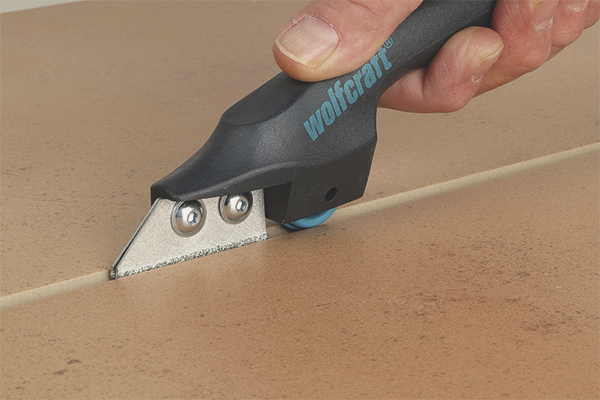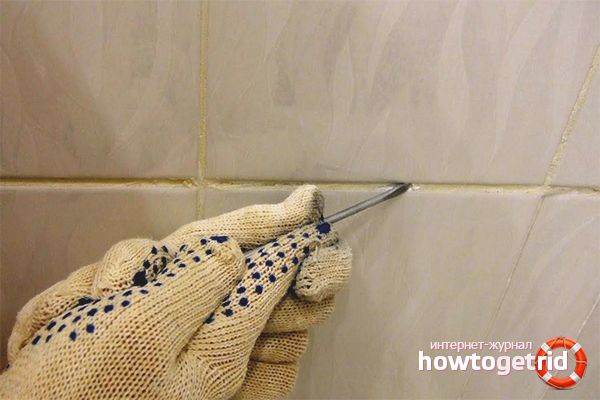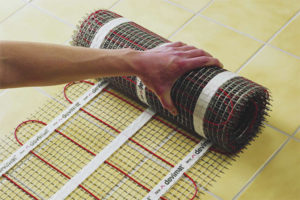The content of the article
Grout for joints, even the highest quality and expensive, absorbs particles of moisture and dust. With time, the material becomes grayish. In silicone mixtures, fungus and mold can multiply, which spoils the appearance of the walls and threatens the health of residents. Tile grouting is attempted to be whitened, washed with soapy water or sanitized, but it is much easier to remove the old compound from the joints and replace it with a new one.
Preparation for work
The ceramic coating is wiped with a damp sponge soaked in warm water. In the liquid add a little detergent or 20-30 g of soap. The tile is wiped with a wet cloth to remove dirt and greasy stains, as well as prepare to remove the grout. Moisture protects the ceramic surface from cracks, scratches and chips.
Before starting work, gently knock the tile with a rubber hammer orwooden stick. If a muffled echo is heard inside, indicating voids, the mechanical method is contraindicated. You cannot use the manual method if the tile is loose or loose on the wall. A knife or a drill will damage the cement mortar on which the facing material rests, and you will have to remove tile and tile together with grouting, and then make repairs.
Do not neglect the protective equipment:
- building glasses;
- respirator;
- rubber or thick cloth gloves;
- clothes with long sleeves.
When removing the old grout in the air dust particles that are deposited on the mucous membrane of the nose and bronchi rise, causing inflammation and coughing. A gauze bandage or a special respirator will protect the airways from irritation.
A person who uses a drill or grinder is recommended to wear glasses. Mechanical removal pieces of grout can bounce off and get into the eyes, injuring the mucous membrane. When working with electric tools can not do without thick gloves that will save your hands and fingers from cuts.
You need to take care of the furniture: sink, washing machine, bath.Objects that cannot be taken out of the room are covered with old blankets or blankets, and they are wrapped with film on top so that you do not have to scrub the white surface from traces of dirt. Skirtings from dust and residues of grout protect the wide building tape. If you need to update the walls, 2-3 layers of old newspapers are laid on the floor.
Softening of cement and silicone compounds
Wet grout is easier than dry, separated from the concrete base. Seams before machining soaked with warm water or soapy water. Cement-sand compositions and silicone varieties soften with acids:
- acetic acid;
- lemon;
- sulfuric.
They run slower than synthetic solvents, but cost a penny.
Preparing a homemade solution from vinegar is simple:
- Dilute 20 ml of the additive with 1 l of water, stir.
- Wear rubber gloves, take a sponge and soak the seams with the workpiece.
- Leave on for 12 hours, and then remove the grout.
If there is no essence, 9% table vinegar will do. The workpiece is diluted with water in a ratio of 1 to 2. The solution will soften the grout in a day.
Vinegar gives off an unpleasant smell, so some people prefer softeners made from citric acid. A concentrated solution will be needed, so a sachet of the dry component is taken for 1 l of liquid. Water is heated to completely dissolve citric acid. A warm liquid is filtered through a gauze, clearing particles of crystals. Put on the grout with a brush or cloth. Cement or silicone paste is plentifully greased with a solution of citric acid, and after a day is cleaned mechanically.
Sulfuric acid is diluted with water in a ratio of 1 to 20. Synthetic substance is added to the liquid, not vice versa, otherwise the workpiece will begin to foam and fall on the walls or skin. The edges of the tile before applying such a solution are stuck with construction tape. Liquid impregnate the grout, waiting for 5-6 hours. It is recommended to apply the solution with a thin brush. Protect your hands from burns with thick rubber gloves.
Acids, especially hydrochloric, emit toxic fumes. After softening the grout, the room is thoroughly aired. Enter the room only in a respirator.After the mechanical grout has been removed, the tile is wiped with wet rags to remove any acid residues.
A safer solution for softening cement and silicone pastes prepared from glycerin. Mix 100 ml of the substance with a glass of hot water. Soak the seams with the agent and wait until the grout is soft and pliable. Glycerin is not washed off with soap solutions. Hot water will not help either. The remains of the substance is removed with a dry cloth, and then the ceramic surface is degreased with kerosene diluted with water.
Other formulations
Epoxy grout, in which there are resins, more resistant. Such material will soften the special solvent, which is sold in hardware stores. The most popular brands are:
- MONOMIX CLEANER GEL;
- Atlas Szop;
- Litoclean;
- PUFAS CEMENT-EX;
- KIILTO CLEAN.
Solvents are perfume types: liquid and gels. The first variety is applied to the grout with a brush. The second is produced in tubes with special dispensers. Gels are designed to handle hard-to-reach areas.
Solvents impregnate the seams. Means are smoothed with rubber spatulas or fingers dipped in water. Synthetic solutions are left for several hours or days, and then scrape off the remains of the grout with wet rags or sponges.Softened epoxy compounds are cleaned with a spatula or paper knife.
Synthetic tools do well with cement-sand pastes and silicone. They completely dissolve such grouting, so you do not have to scrape the remnants of a spatula or a drill. After the use of chemical preparations, the seams are wiped with moist cotton buds and brushes with stiff bristles.
Mechanical removal
The edges of ceramic tiles are sealed with masking tape. Take a knife for paper or tiled binder. Another tool with a thin sharp blade will do. The tip of the knife is held in the center of the seam. They try to drive the instrument as deep as possible so that it reaches the concrete base.
Grout, soaked with acid or synthetic solution, falls off in large chunks. The remains of cement or silicone paste are cleaned with a paper knife. The blade moves from the edge of the seam to the center. It is necessary to try so that the tool does not touch the ceramic surface, otherwise scratches and cracks will remain on the tile.
Removing grout with a stationery knife is monotonous and boring. Clean the seams in 2-3 hours with a drill. Electric tools are equipped with a needle-thin nozzle.It should be less than the distance between the tiles. Recommend a drill for glass or ceramics. Too thick nozzles leave scratches on the cladding material and cause chipping.
The drill is firmly squeezed with one or two hands. Turn on the minimum speed to make it easier to manage the tool. Handle seams 1–2 times until the drill reaches the concrete base.
Instead of a drill, use a grinder. But only professional can handle such tools. For beginners, it is difficult to remove grout without grinder without damaging the facing material, because the disks often slide off and touch the edges of the tile.
After mechanical cleaning, the seams are sanded with emery paper. Abrasive particles remove the remains of cement or epoxy paste from a concrete base. Use a metal brush or an old toothbrush. Tools sweep dust from seams and tiles, remove particles of the dried solution.
It remains to wipe the wall and cladding with a damp cloth. You can moisten it in a solution of detergent. Choose options that contain acids. The seams are cleaned of dirt with cotton swabs, and they must be degreased before applying the new grout.It is recommended to apply a solution of water and kerosene or white spirit. 500 ml liquid tablespoon of synthetic component.
Even a beginner who never had a spatula in his hands can remove the old grout from the seams. It's very simple: soak, scrape, sand and degrease. It does not make sense to remove the grout if the tile is loose or loose on the wall. In such cases, you will have to start a full repair with a complete replacement of the facing material.
Video: how to remove epoxy grout from tile joints












To send